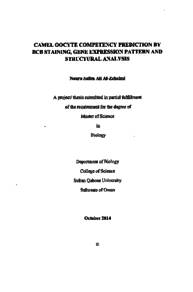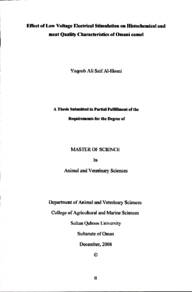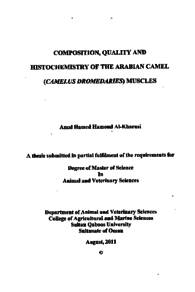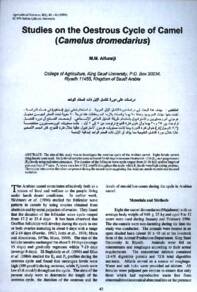وثيقة
Camel Oocyte Competency Prediction by BCB Staining, Gene Expression Pattern and Structural Analysis
الناشر
Sultan Qaboos University
ميلادي
2014
اللغة
الأنجليزية
الملخص الإنجليزي
Dromedary camels are economically and culturally valuable animals in the Arabian Peninsula. However, they face many in vivo and in vitro reproductive challenges. Oocyte quality plays a key role in maximizing the success of embryo development and production. Therefore, this study is conducted to evaluate camel oocytes quality using multiparametric assessment; enzymatic, molecular, fluorescent and structural analysis. Dromedary camel ovaries (n=80, between 4 to 14 years old) were obtained from local slaughterhouses (Sinaw and Salalah) during the breeding season (December to April) and non-breeding season (May to October). Camel oocytes were recovered by aspiration and/or slicing of ovaries. Cumulus oocyte complexes (COCs) were stained with 26 UM BCB for 90 min. Unstained COCs were used as a control (BCBc). Stained COCs were categorized according to cytoplasmic coloration into BCB+ and BCB- and their diameter were measured under a stereomicroscope. Marker genes for competency were used in this study (COX2, COX3, ATP6, NDS, CYTB, TNFa, HSPAIB, GSTT1 and ZP3). GAPDH was used as a housekeeping gene for normalization, Quantitative gene expression analysis was carried out by total RNA extraction from denuded oocytes and cumulus cells (CCs) from all three groups (BCBC, BCB+ and BCB-) with the use of RNeasy® Mini Kit. Reverse transcription was performed by Omniscript followed by cDNA amplification with Taq PCR Core Kit. Fluorescent assessment of the mitochondrial distribution and membrane potential was carried out with Rhodamine 123 and JC-1 staining, respectively. Zona pellucida surface structure was assessed by scanning electron microscopy and the pore size was measured by CorelDRAW software. The data were analyzed with independent t-test and one way ANOVA using PRISM software. Total numbers of BCB- and BCB+ oocytes were 399 and 276 respectively. During the reproductive season, the mean = SE of BCB+ oocytes collected after 2h post collection were significantly lower (P<0.05) from those recovered after 24h. BCB staining showed no difference in the number of BCB+ oocytes in neither reproductive nor non reproductive seasons (P>0.05). BCB+ oocytes mean diameter (um) was significantly larger (P < 0.05) in BCB+ oocytes. Camel oocytes and their surrounding CCs displayed down-regulation pattern in two mitochondrial genes (COX3 & CYTB). Similar expression pattern was observed in nuclear genes, whereas stress related genes, TNFa and GSTT1 were down-regulated in BCB- and BCB+ oocytes compared to the control. Mitochondrial distribution pattern of BCB and BCB+ oocytes exhibit good maturation levels. Mitochondrial membrane potential was equal in BCB groups. Three zona pellucida surface morphology types were found in camel oocyte; ZP type I for BCB+ oocytes, ZP type II for BCB oocytes and ZP type III for BCBC oocytes. Pore sizes were small and not significantly different in BCBC, BCB- and BCB+ oocytes. In conclusion, oocytes selected by BCB staining and validated by multi-assessments failed to provide a clear distinction between BCB- and BCB+. Therefore, similar to pigs and horses, BCB staining is unsuitable test for camel oocytes selection. Conversely however, gene expression pattern and mitochondrial potential and distribution as well surface structure of ZP improve oocytes cytoplasmic and nuclear maturation prediction. The future of embryo assessment will rely on objective evaluation associated with genomics, proteomics and metabolomics technologies.
الوصف
Thesis
المجموعة
URL المصدر
الملخص العربي
تعتبر الأبل ذات السنام الواحد من أكثر الحيوانات ذات قيمة اقتصادية وثقافية في شبهالجزيرة العربية. ومع ذلك فإنها تواجه العديد من التحديات الإنجابية. جودة البييضة وكفاءتها في التخصيب يلعبان دورا رئيسيا في تحقيق أقصى قدر من النجاح لتطور ونمو الجنين بشكل سليم ولذا، فإننا قمنا بإجراء أول دراسة لتقييم جودة البييضات في الأبل عن طريق الإختبار الإنزيمي، الجزینی، الفلورنسي والتحليل البنيوي. تم الحصول على مبايض الابل االمستخدمة في الدراسة أن = ۸۰، یہ 6 إلى ۱۲ سنة) من المسالخ المحلية (سناو وصلالة) خلال موسم التكاثر (ديسمبر - أبريل) وخارج الموسم (مايو- أكتوبر). تم استخراج البيضات من خلال سحبها من المبيض باستخدام أبرة أو عن طريق تقطيع بعض أجزاء المبيض. تبع ذلك صبغ البويضات و خلايا الركام المبيضي(COCs) المستخرجة من المبيض بصبغة تسمي BCB (۲۹ میکرومولر لمدة ۹۰ دقيقة). تم ترك مجموعة من البييضات بدون صبغة كمجموعة ضابطة صنفت البييضات وفقا للون صبغة السيتوبلازم +BCB و-BCB، وتم قياس قطر النوعيين باستخدام مجهر Stereomicroscope. لزيادة كفاءة هذه الدراسة تم استخدام بعض جينات النواة والميتوكندريا ( ND5، ATP6 ، COX3 CoX2 GSTT1 ،HSPAI TNFa CYTB وZP3) كدليل للجودة. وقد استخدم GAPDH كجين محافظ (Housekeeping genes). تم اجراء التحليل الكمي للنشاط الجيني باستخراج مجموع الحمض النووي الريبوزي من البييضات والخلايا المجاورة لها من جميع المجموعات الثلاث ( BCB + BCBc و-BCB) باستخدام RNeasy Mini Kit وأجري النسخ العكسي بواسطة Omniscript تليها مضاغفة عدد النسخ الجينية باستخدام Tag PCR Core Kit. تم اختبار توزيع الميتوكندريا وإمكانات الغشاء الخارجي للبييضة باستخدام صبغتي 123 Rhodamine و 1-JC على ا.لتوالي كما تم تقييم مورفولوجيا السطح المنطقة الشفافة زونا (Zona pellucida) باستخدام المجهر الإلكتروني وتم قياس حجم المسام باستخدام برنامج CorelDRAW. حللت البيانات عن طريق t - test و ANOVA ببرنامج PRISM بلغ إجمالي عدد بيضات -BCB و +BCB حوالي ۳۹۹ و ۲۷۹ على التوالي. خلال موسم التكاثر، كانت بيضات +BCB التي تم جمعها بعد ساعتين (۷۰ بيبضة أقل إحصائيا ( 0 . 05>P) من تلك التي استخرجت بعد ٢٤ ساعة (۲۰۱ ببيضة). أظهرت نتائج صبغة ال BCB انه لا يوجد فرق كبير في علد بويضات +BCB في موسمي الشتاء أو الصيف. كما أوضحت النتائج أيضا أن متوسط قطر بيضات +BCB أكبر بكثيير من بيضات -BCB. يتسم النشاط الجيني للميتوكندريا في البييضات والخلايا المجاورة بالضعف (Cox3 & CYTB). وقد لوحظ نمط مماثل للنشاط الجيني النووي ولكن بطريقةإيجابية، حيث لوحظ نشاط منخفض الجينات مسؤولة عن خفض جودة البييضة (TNFd و GSTT) في بييضات -BCB و +BCB مقارنة بالمجموعة الضابطة. في الجانب الأخر أظهر نمط توزيع الميتوكندريا من النوعيين نضوج البويضات بشكل متماثل. كما أن إمكانات غشاء الميتوكوندريا متساوية في مجموعات BCB. ومن االمثير للاهتمام، ظهرت ثلاثة أنواع المورفولوجيا يسطح المنطقة الشفافة للبييضة؛ النوع الأول (ZP type I) يوجد في بييضة +BCB والنوع الثاني (ZP type II) في ببيضة -BCB والنوع الثالث (ZP type III) في بييضة BCBc. وكانت أحجام المسام في المنطقة الشفافة صغيرة ولا تختلف اختلافا كبيرا في بييضات BCB - BCBc و +BCB. يمكن القول أن البييضات التي يتم اختيارها وتصنيفها عن طريق صبغة BCB لا تعطي تمييزا واضحا بين -BCB و +BCB من خلال تقييمها بطرق أخرى متعددة،. لذا، على غرار الخنازير والخيول، صبغة BCB ليست اختبارا جيدا لاختيار جودة البييضات في الأبل. النشاط الجيني وتوزيع الميتوكوندريا ونشاطها مع تقيم مورفولوجيا ZP تعطي صورة كاملة عن نضوج البييضة السيتوبلازمي والنووي. في المستقبل سيعتمد تقييم الجنين على التقييم المرتبط بالتكنولوجيات الجينومية، والبروتينة و الأيضية
قالب العنصر
الرسائل والأطروحات الجامعية





